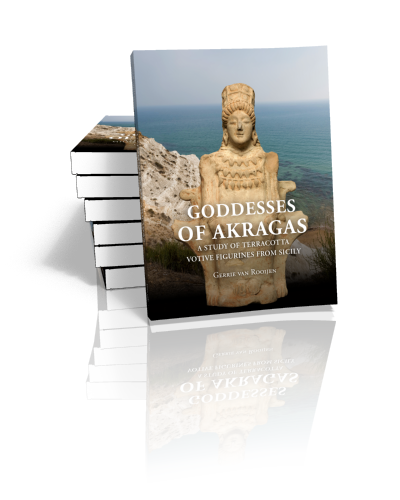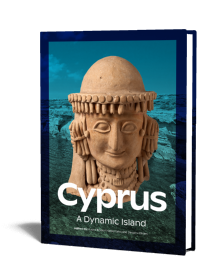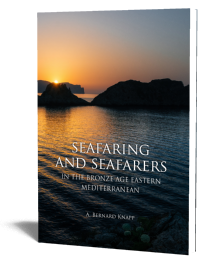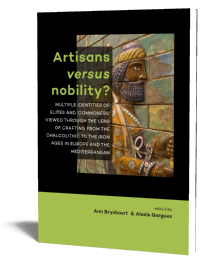Goddesses of Akragas
A Study of Terracotta Votive Figurines from Sicily
Gerrie van Rooijen | 2021

Goddesses of Akragas
A Study of Terracotta Votive Figurines from Sicily
Gerrie van Rooijen | 2021
Paperback ISBN: 9789088909009 | Hardback ISBN: 9789088909016 | Imprint: Sidestone Press Dissertations | Format: 210x280mm | 388 pp. | Language: English | 5 illus. (bw) | 250 illus. (fc) | Keywords: classical archaeology; figurines; coroplastics; terracotta; votives; Sicily; archaeological experiment; moulding techniques; migration | download cover
Read online or downloaded 305 times
-
Digital & Online access
This is a full Open Access publication, click below to buy in print, browse, or download for free.
-
Buy via Sidestone (EU & UK)
-
Buy via our Distributors (WORLD)
For non-EU or UK destinations you can buy our books via our international distributors. Although prices may vary this will ensure speedy delivery and reduction in shipping costs or import tax. But you can also order with us directly via the module above.
UK international distributor
USA international distributor
-
Bookinfo
Paperback ISBN: 9789088909009 | Hardback ISBN: 9789088909016 | Imprint: Sidestone Press Dissertations | Format: 210x280mm | 388 pp. | Language: English | 5 illus. (bw) | 250 illus. (fc) | Keywords: classical archaeology; figurines; coroplastics; terracotta; votives; Sicily; archaeological experiment; moulding techniques; migration | download cover
Read online or downloaded 305 times

We will plant a tree for each order containing a paperback or hardback book via OneTreePlanted.org.
The terracotta figurines from Akragas (Agrigento) with their chubby faces, splendid furniture, and rich adornments, depict a prosperous life in the late sixth and early fifth century BCE. The extensive jewellery on the figurines contains strikingly large fibulae appliques fastening pectoral chains with several sorts of pendants. They are modelled after existing items. The form of the jewellery items changed fast, influenced by different peoples and changing fashions, which can be compared with representations of jewellery and fashion on coins of the same period from Syracuse.
In contrast, the body of the figurines remained armless and abstract for some time, nor does it express its gender. The block shaped, sloping upper body might have originated with aniconic objects, but suggests here a seated person, covered with a rectangular apron on the front. In contrast, the face is detailed, and often crowned with a specific headgear, the polos. The Archaic smile reveals Greek influence on its features.
An archaeological experiment in which figurines and moulds were reproduced revealed their production process. By combining data from the experiment with an analysis of their iconographic features, most of the figurines studied can be shown to have been designed and produced locally. The moulding technique, introduced by newcomers to the city, provided for relatively cheap and rapid production of terracotta figurines. Local clay and marl are found near to the city, and its composition was found to be very suitable, due to its plasticity, fine structure and soft tone on firing.
Wooden figurines, the forerunners of the terracotta figurines, were used in the production of the moulds of their terracotta successors. The terracotta figurines developed to become more three-dimensional, so that they were able to stay upright unsupported. Objects and moulds were exchanged with the city of Selinous, resulting in variations of the standard and figurines with finely detailed faces.
Designing and dedicating these votive figurines, and possibly also jewellery, to a cult statue might have acted as a unifying element for the perhaps multi-ethnic society of Akragas. By means of these anthropomorphic female figurines, people gave shape to their origin and narratives, using old and new symbols such as the Phoenician crescent and the Greek satyr. Their cultural influences formed a new religious setting, helping to forge a new identity unique to Sicily. The prosperity expressed by these metal adornments, fits Diodorus Siculus’ description of Akragas as a rich city.
List of figures with references
I Akragantine figurines and their context
I.1 Introduction
I.2 State of research
I.2.a Identifying the figurine and the dedicants
I.2.b Proving literature right by the archaeological material
I.2.b.i Cult transfer and a prototype reconstruction
I.2.c Athena Lindia? Rhodian and Sicilian figurines compared
I.2.d Other views on identification and origin
I.2.e Oikist cult and cultural identity formation
I.2.f Intermarriage and gender
I.3 Aims and research questions
I.4 Method and archaeological theory
I.5 Research structure
I.6 Greek historiography on Sicily – some general remarks
I.6.a Mythical past
I.6.b Political setting
I.6.b.i The perception of ancient authors
I.6.b.ii Sicily in the account of Thucydides
I.6.b.iii The foundation of Gelas and Akragas
I.6.b.iii.1 Gelas
I.6.b.iii.2 Herodotus on Gelas
I.6.b.iii.3 Akragas
I.6.b.iii.4 Herodotus on Theron of Akragas
I.6.c Social and economic setting
I.6.c.i Diversity among the inhabitants of Sicily
I.6.c.ii Phoenicians
I.6.c.iii Prosperity of Akragas
I.6.d Religious setting
I.6.d.i Demeter and Persephone on Sicily
I.6.d.ii Temple building and politics
I.6.e Conclusions on the ancient literary sources
II Iconography of the figurines
II.1 Introduction
II.2 Aims
II.3 Method
II.4 The body
II.4.a The local tradition
I.4.a.i Arms and feet
II.4.b Imported and imitated images
II.4.c Upright
II.4.d From wood to terracotta
II.4.e An aniconic tradition
II.4.f Gender
II.4.g Practical implications of the figurines’ form
II.4.h The form of the figurines and their role as votives
II.5 Head and face
II.5.a General shape and expression of the face
II.5.b A personal expression
II.5.c Cultural influences
II.5.c.i Noses
II.5.c.ii Mouth and chin
II.5.c.iii Eyes
II.5.c.iv Ears
II.5.c.v Hair
II.5.d Gender
II.6 Dress and personal adornment
II.6.a The apron
II.6.b Non-Sicilian garments
II.6.b.i The undergarment
II.6.c Cultic dress
II.6.d Footwear
II.6.e Headgear
II.6.e.i Veil
II.6.e.ii Polos
II.6.e.iii The meaning of the polos and veil
II.6.e.iii The headdress as an indication of marital status
II.6.f Fibulae
II.6.f.i Interpretation and comparison with real-life objects
II.6.g Pectoral bands and pendants
II.6.g.i Akragantine pendants
II.6.h.ii Linked to the locals: pectoral bands
II.6.h.iii Discs and crescents
II.6.h.iv Figurative pendants
II.6.h.v Other beads and pendants with their real-life counterparts from other sites
II.6.h.vi Comparison with other cultures
II.6.h.vii Cultural exchange
II.6.h.viii Function and meaning
II.6.h Other jewellery
II.6.h.i Ear studs and earrings
II.6.h.ii Bracelets
II.6.h.iii Necklaces and hairbands
II.6.h.iv Comparison with korai jewellery
II.6.i Gender, identity and the display of wealth
II.7 Furniture
II.7.a From bench to throne
II.7.a.i The footstool
II.7.b The origin of the represented chair shapes
II.7.b.i Greek chairs: thronos and klismos
II.7.b.ii Thrones and lions
II.7.b.iii An enthroned couple
II.7.c Gender and identity
II.8 Conclusions
III The technology of Akragantine figurines
III.1 Introduction
III.2 Aims of technical research
III.3 Method: An archaeological experiment with analogue reconstruction
III.4 Interpretation and the chaîne opératoire approach
III.5 The general production process
III.5.a Object categories
III.5.b Solid objects and plaques
III.5.c Description of the steps in the production process
III.6 The coroplastic experiment
III.7 Results of the experiment and comparison with features of the original objects
III.7.a Step 1: The clays used in Akragas
III.7.b Steps 2 and 3: Choice of patrix and creating the matrix
III.7.c Step 4: Aspects of the shaping process and related items
III.7.c.i Making the front of the figurine
III.7.c.ii Making the back of the figurine
III.7.c.iii Making an extra rim
III.7.c.iv Drying and deformation
III.7.c.v The derivative mould
III.7.c.vi Time management and additions
III.7.c.vii Retouching and tools
III.8 The production of other types of objects
III.9 Interpretation and discussion
III.9.a Implications of the introduction of the moulding technique
III.10 Identification of coroplastic workshops by different techniques
III.10.a The Workshop of the White Clay
III.10.b The Workshop of the Convex Back
III.10.c The Workshop of Straight Reworking
III.10.d The Workshop of the Chubby Faces and the One Pendant Necklace
III.10.e The skills of the coroplast
III.11 The coroplastic exchange between Sicilian towns
III.11.a Terracotta production at the kerameikos of Selinous and workshops in Akragas
III.12 Conclusions
IV Technically and iconographically defined typology
Group 1
Group 2
Group 3
Group 4
Group 5
Group 6
Chronological overview of the groups
V Conclusion
V.1 Concerning literary sources
V.2 Concerning iconography
V.3 Concerning production techniques
V.4 Concerning meaning and use
Bibliography
Catalogue
How to use the catalogue
Overview of the locations and contexts of findspots for figurines
Abbreviations/references for museum collections with figurines from Akragas
Type A: Argive Type (no.1‑2)
Type B: Face-moulded figurines (no.3‑7)
Type C: block-like figurines (no.8‑64)
Type D: Some characteristic faces and standing figurines (65‑70)
Type E: Imported figurines with rounded shapes, and objects inspired by them (71‑76)
Type F: Exceptional objects (77‑86)
Type G: Standing group (87‑97)
Type H: A variety of pendants (98‑106)
Type I: The same head, a different body (107‑114)
Type J: A patterned polos (115‑137)
Type K: The outlined-throne throne group and some similar figurines (no.138‑153)
Type L: other polos-wearing heads (154‑170)
Type M: The chubby face (171‑184)
Type N: A new hairstyle and widened polos (185‑197)
Type O: Seated on the left shoulder (198‑200)
Type P: Earrings (201‑202)
Dr. Gerrie van Rooijen
Gerrie obtained a Bachelor’s degree in Classics and a Master’s degree in Archaeology, specialising in Mediterranean Archaeology. She is fascinated by both the literature and the material culture of Antiquity, with a special interest in sculpture. In 2017 she published the first results of an archaeological experiment regarding the terracotta figurines from Akragas in an article titled Figuring out: coroplastic art and technè in Agrigento, Sicily: the results of a coroplastic experiment, published in Analecta Praehistorica Leidensia 47 (Van Rooijen et al. 2017, 151-161). Meanwhile she teaches Ancient Greek and Latin Languages and Culture at a high school.
Abstract:
The terracotta figurines from Akragas (Agrigento) with their chubby faces, splendid furniture, and rich adornments, depict a prosperous life in the late sixth and early fifth century BCE. The extensive jewellery on the figurines contains strikingly large fibulae appliques fastening pectoral chains with several sorts of pendants. They are modelled after existing items. The form of the jewellery items changed fast, influenced by different peoples and changing fashions, which can be compared with representations of jewellery and fashion on coins of the same period from Syracuse.
In contrast, the body of the figurines remained armless and abstract for some time, nor does it express its gender. The block shaped, sloping upper body might have originated with aniconic objects, but suggests here a seated person, covered with a rectangular apron on the front. In contrast, the face is detailed, and often crowned with a specific headgear, the polos. The Archaic smile reveals Greek influence on its features.
An archaeological experiment in which figurines and moulds were reproduced revealed their production process. By combining data from the experiment with an analysis of their iconographic features, most of the figurines studied can be shown to have been designed and produced locally. The moulding technique, introduced by newcomers to the city, provided for relatively cheap and rapid production of terracotta figurines. Local clay and marl are found near to the city, and its composition was found to be very suitable, due to its plasticity, fine structure and soft tone on firing.
Wooden figurines, the forerunners of the terracotta figurines, were used in the production of the moulds of their terracotta successors. The terracotta figurines developed to become more three-dimensional, so that they were able to stay upright unsupported. Objects and moulds were exchanged with the city of Selinous, resulting in variations of the standard and figurines with finely detailed faces.
Designing and dedicating these votive figurines, and possibly also jewellery, to a cult statue might have acted as a unifying element for the perhaps multi-ethnic society of Akragas. By means of these anthropomorphic female figurines, people gave shape to their origin and narratives, using old and new symbols such as the Phoenician crescent and the Greek satyr. Their cultural influences formed a new religious setting, helping to forge a new identity unique to Sicily. The prosperity expressed by these metal adornments, fits Diodorus Siculus’ description of Akragas as a rich city.
Contents
List of figures with references
I Akragantine figurines and their context
I.1 Introduction
I.2 State of research
I.2.a Identifying the figurine and the dedicants
I.2.b Proving literature right by the archaeological material
I.2.b.i Cult transfer and a prototype reconstruction
I.2.c Athena Lindia? Rhodian and Sicilian figurines compared
I.2.d Other views on identification and origin
I.2.e Oikist cult and cultural identity formation
I.2.f Intermarriage and gender
I.3 Aims and research questions
I.4 Method and archaeological theory
I.5 Research structure
I.6 Greek historiography on Sicily – some general remarks
I.6.a Mythical past
I.6.b Political setting
I.6.b.i The perception of ancient authors
I.6.b.ii Sicily in the account of Thucydides
I.6.b.iii The foundation of Gelas and Akragas
I.6.b.iii.1 Gelas
I.6.b.iii.2 Herodotus on Gelas
I.6.b.iii.3 Akragas
I.6.b.iii.4 Herodotus on Theron of Akragas
I.6.c Social and economic setting
I.6.c.i Diversity among the inhabitants of Sicily
I.6.c.ii Phoenicians
I.6.c.iii Prosperity of Akragas
I.6.d Religious setting
I.6.d.i Demeter and Persephone on Sicily
I.6.d.ii Temple building and politics
I.6.e Conclusions on the ancient literary sources
II Iconography of the figurines
II.1 Introduction
II.2 Aims
II.3 Method
II.4 The body
II.4.a The local tradition
I.4.a.i Arms and feet
II.4.b Imported and imitated images
II.4.c Upright
II.4.d From wood to terracotta
II.4.e An aniconic tradition
II.4.f Gender
II.4.g Practical implications of the figurines’ form
II.4.h The form of the figurines and their role as votives
II.5 Head and face
II.5.a General shape and expression of the face
II.5.b A personal expression
II.5.c Cultural influences
II.5.c.i Noses
II.5.c.ii Mouth and chin
II.5.c.iii Eyes
II.5.c.iv Ears
II.5.c.v Hair
II.5.d Gender
II.6 Dress and personal adornment
II.6.a The apron
II.6.b Non-Sicilian garments
II.6.b.i The undergarment
II.6.c Cultic dress
II.6.d Footwear
II.6.e Headgear
II.6.e.i Veil
II.6.e.ii Polos
II.6.e.iii The meaning of the polos and veil
II.6.e.iii The headdress as an indication of marital status
II.6.f Fibulae
II.6.f.i Interpretation and comparison with real-life objects
II.6.g Pectoral bands and pendants
II.6.g.i Akragantine pendants
II.6.h.ii Linked to the locals: pectoral bands
II.6.h.iii Discs and crescents
II.6.h.iv Figurative pendants
II.6.h.v Other beads and pendants with their real-life counterparts from other sites
II.6.h.vi Comparison with other cultures
II.6.h.vii Cultural exchange
II.6.h.viii Function and meaning
II.6.h Other jewellery
II.6.h.i Ear studs and earrings
II.6.h.ii Bracelets
II.6.h.iii Necklaces and hairbands
II.6.h.iv Comparison with korai jewellery
II.6.i Gender, identity and the display of wealth
II.7 Furniture
II.7.a From bench to throne
II.7.a.i The footstool
II.7.b The origin of the represented chair shapes
II.7.b.i Greek chairs: thronos and klismos
II.7.b.ii Thrones and lions
II.7.b.iii An enthroned couple
II.7.c Gender and identity
II.8 Conclusions
III The technology of Akragantine figurines
III.1 Introduction
III.2 Aims of technical research
III.3 Method: An archaeological experiment with analogue reconstruction
III.4 Interpretation and the chaîne opératoire approach
III.5 The general production process
III.5.a Object categories
III.5.b Solid objects and plaques
III.5.c Description of the steps in the production process
III.6 The coroplastic experiment
III.7 Results of the experiment and comparison with features of the original objects
III.7.a Step 1: The clays used in Akragas
III.7.b Steps 2 and 3: Choice of patrix and creating the matrix
III.7.c Step 4: Aspects of the shaping process and related items
III.7.c.i Making the front of the figurine
III.7.c.ii Making the back of the figurine
III.7.c.iii Making an extra rim
III.7.c.iv Drying and deformation
III.7.c.v The derivative mould
III.7.c.vi Time management and additions
III.7.c.vii Retouching and tools
III.8 The production of other types of objects
III.9 Interpretation and discussion
III.9.a Implications of the introduction of the moulding technique
III.10 Identification of coroplastic workshops by different techniques
III.10.a The Workshop of the White Clay
III.10.b The Workshop of the Convex Back
III.10.c The Workshop of Straight Reworking
III.10.d The Workshop of the Chubby Faces and the One Pendant Necklace
III.10.e The skills of the coroplast
III.11 The coroplastic exchange between Sicilian towns
III.11.a Terracotta production at the kerameikos of Selinous and workshops in Akragas
III.12 Conclusions
IV Technically and iconographically defined typology
Group 1
Group 2
Group 3
Group 4
Group 5
Group 6
Chronological overview of the groups
V Conclusion
V.1 Concerning literary sources
V.2 Concerning iconography
V.3 Concerning production techniques
V.4 Concerning meaning and use
Bibliography
Catalogue
How to use the catalogue
Overview of the locations and contexts of findspots for figurines
Abbreviations/references for museum collections with figurines from Akragas
Type A: Argive Type (no.1‑2)
Type B: Face-moulded figurines (no.3‑7)
Type C: block-like figurines (no.8‑64)
Type D: Some characteristic faces and standing figurines (65‑70)
Type E: Imported figurines with rounded shapes, and objects inspired by them (71‑76)
Type F: Exceptional objects (77‑86)
Type G: Standing group (87‑97)
Type H: A variety of pendants (98‑106)
Type I: The same head, a different body (107‑114)
Type J: A patterned polos (115‑137)
Type K: The outlined-throne throne group and some similar figurines (no.138‑153)
Type L: other polos-wearing heads (154‑170)
Type M: The chubby face (171‑184)
Type N: A new hairstyle and widened polos (185‑197)
Type O: Seated on the left shoulder (198‑200)
Type P: Earrings (201‑202)
Dr. Gerrie van Rooijen
Gerrie obtained a Bachelor’s degree in Classics and a Master’s degree in Archaeology, specialising in Mediterranean Archaeology. She is fascinated by both the literature and the material culture of Antiquity, with a special interest in sculpture. In 2017 she published the first results of an archaeological experiment regarding the terracotta figurines from Akragas in an article titled Figuring out: coroplastic art and technè in Agrigento, Sicily: the results of a coroplastic experiment, published in Analecta Praehistorica Leidensia 47 (Van Rooijen et al. 2017, 151-161). Meanwhile she teaches Ancient Greek and Latin Languages and Culture at a high school.
-
Digital & Online access
This is a full Open Access publication, click below to buy in print, browse, or download for free.
-
Buy via Sidestone (EU & UK)
-
Buy via our Distributors (WORLD)
For non-EU or UK destinations you can buy our books via our international distributors. Although prices may vary this will ensure speedy delivery and reduction in shipping costs or import tax. But you can also order with us directly via the module above.
UK international distributor
USA international distributor
- Browse all books by subject
-
Search all books

We will plant a tree for each order containing a paperback or hardback book via OneTreePlanted.org.
You might also like:
© 2025 Sidestone Press KvK nr. 28114891 Privacy policy Sidestone Newsletter Terms and Conditions (Dutch)








